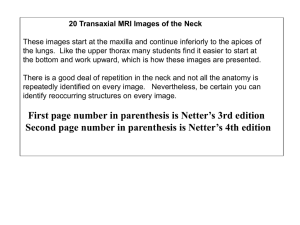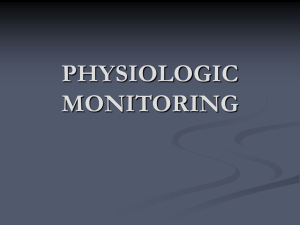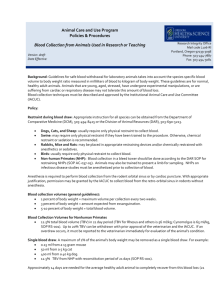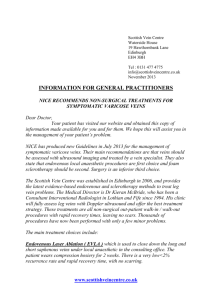An angiographic study of the carotid arterial and jugular venous
advertisement
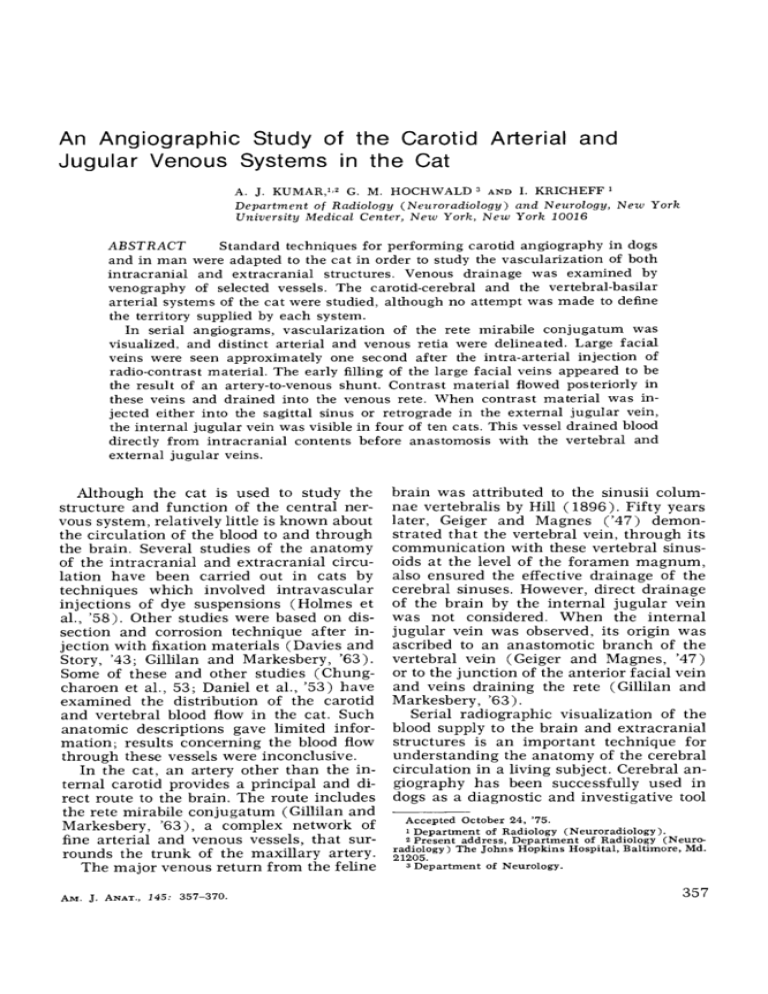
An Angiographic Study of the Carotid Arterial and
Jugular Venous Systems in the Cat
A. J. KUMAR,'J G. M. HOCHWALD AND I. KRICHEFF
D e p a r t m e n t of Radiology ( N e u r o r a d i o l o g y ) and Neurology, N e w Y o r k
University Medical Center, N e w Y o r h , N e w Y o r k 10016
Standard techniques for performing carotid angiography in dogs
and in man were adapted to the cat in order to study the vascularization of both
intracranial and extracranial structures. Venous drainage was examined by
venography of selected vessels. The carotid-cerebral and the vertebral-basilar
arterial systems of the cat were studied, although no attempt was made to define
the territory supplied by each system.
In serial angiograms, vascularization of the rete mirabile conjugatum was
visualized, and distinct arterial and venous retia were delineated. Large facial
veins were seen approximately one second after the intra-arterial injection of
radio-contrast material. The early filling of the large facial veins appeared to be
the result of an artery-to-venous shunt. Contrast material flowed posteriorly in
these veins and drained into the venous rete. When contrast material was injected either into the sagittal sinus or retrograde in the external jugular vein,
the internal jugular vein was visible in four of ten cats. This vessel drained blood
directly from intracranial contents before anastomosis with the vertebral and
external jugular veins.
ABSTRACT
Although the cat is used to study the
structure and function of the central nervous system, relatively little is known about
the circulation of the blood to and through
the brain. Several studies of the anatomy
of the intracranial and extracranial circulation have been carried out in cats by
techniques which involved intravascular
injections of dye suspensions (Holmes e t
al., '58). Other studies were based on dissection and corrosion technique after injection with fixation materials (Davies and
Story, '43; Gillilan and Markesbery, '63).
Some of these and other studies (Chungcharoen et al., 53; Daniel et al., '53) have
examined the distribution of the carotid
and vertebral blood flow in the cat. Such
anatomic descriptions gave limited information; results concerning the blood flow
through these vessels were inconclusive.
I n the cat, a n artery other than the internal carotid provides a principal and direct route to the brain. The route includes
the rete mirabile conjugatum (Gillilan and
Markesbery, '63), a complex network of
fine arterial and venous vessels, that surrounds the trunk of the maxillary artery.
The major venous return from the feline
AM. J. ANAT., 145: 357-370.
brain was attributed to the sinusii columnae vertebralis by Hill ( 1 8 9 6 ) . Fifty years
later, Geiger and Magnes ('47) demonstrated that the vertebral vein, through its
communication with these vertebral sinusoids at the level of the foramen magnum,
also ensured the effective drainage of the
cerebral sinuses. However, direct drainage
of the brain by the internal jugular vein
was not considered. When the internal
jugular vein was observed, its origin was
ascribed to an anastomotic branch of the
vertebral vein (Geiger and Magnes, '47)
or to the junction of the anterior facial vein
and veins draining the rete (Gillilan and
Markesbery, '63).
Serial radiographic visualization of the
blood supply to the brain and extracranial
structures is a n important technique for
understanding the anatomy of the cerebral
circulation in a living subject. Cerebral angiography has been successfully used in
dogs a s a diagnostic and investigative tool
Accepted October 24, '75.
1 Department of Radiology (Neuroradiology ).
2 Present address, Department of Radiology (Neuroradiology) The Johns Hopkins Hospital, Baltimore, Md.
21205.
9 Department of Neurology.
357
358
A. J. KUMAR, G. M. HOCHWALD AND I. KRICHEFF
Figs. la-d
Lateral projections of the head and neck of a cat after a retrograde injection
of the common carotid artery. Serial radiographs were obtained at different time intervals
after injection of Reograffin 60.
Fig. l a Radiograph taken 0.5 seconds after injection of contrast material, showing early
arterial phase: branches of the carotid system and arterial component of rete mirabile conjugatum. A, common carotid artery; B, occipital artery; C, ascending pharyngeal; D, internal
carotid artery; E, external maxillary artery; F, lingual artery; G, posterior auricular artery;
H, maxillary artery; I, inferior alveolar artery; J, rete mirabile caroticum (arterial rete);
K, basilar artery; L, vertebral artery; M, posterior communicating arteries; N, retinal artery;
0, contrast-filled catheter in right common carotid artery.
(De La Torre et al., '62; Rising and Lewis,
'72). In the present studies, accepted
techniques for cerebral angiography were
adopted for use in cats. These studies were
initiated to examine the vascularization
of the cat's brain, with special reference
to the circulation through the rete mirabile conjugatum. In addition, radiographic
techniques were used in order to estimate
the contribution of the internal jugular
vein to the venous drainage of the brain.
MATERIALS AND METHODS
Adult mongrel cats of either sex were
anaesthetized with intravenous pentobarbital, 20 mg/kg body weight. Additional
doses of anaesthesia were given as necessary to maintain them lightly anesthetized.
The trachea was intubated, but each animal was allowed to breathe spontaneously.
A heating pad maintained the body temperature at 37-38°C.
Carotid angiography
The right common carotid artery was
teased free from the surrounding tissue
and a PE 190 catheter was inserted into
the vessel. The catheter was passed in a
retrograde direction until the tip entered
the aortic arch. The carotid artery distal
to the catheter was ligated. Rapid serial
angiography was performed by placing the
CAT CAROTID AND JUGULAR CIRCULATION
359
Fig. l b Serial angiogram two seconds after retrograde injection into the common carotid
artery of contrast material, showing intracranial vessels, prominent choroidal blush, both
maxillary arteries, and early filling of facial and ophthalmic veins. A , right and left arterial
rete; B, right and left maxillary artery; C, right and left external carotid; D, middle cerebral
arterial branches; E. small anterior cerebral arterial branches; F, proniinent choroidal blush;
G, ophthalmic veins.
animal either in the lateral or in the inferior-posterior (IP) position. Three milliliters of Renograffin 60 were injected
through the catheter in approximately two
seconds. Rapid serial films were taken with
a Franklin film changer at the rate of 2
films’sec for three seconds, followed by 1
fi1m:sec for six seconds. The x-ray tube
used had a fine focal spot of 0.15 mm. Exposure factors employed were 2 mas and
80 kv with a target focal distance of 75 cm.
The cat was positioned between the film
and the x-ray unit to produce a 2: 1 magnification.
Venography
Selected venography was carried out
with the use of catheters placed in either
the superior sagittal sinus, external jugu-
lar or internal jugular veins. In each study,
the appropriate vessels were isolated and
dissected free from surrounding structures.
The superior sagittal sinus was made accessible through a burr hold directly above
the sinus and approximately 5 m m caudal
to the coronal suture. A PE 50 catheter was
introduced into the sinus, directed caudally
and sealed into position with an acrylic
tissue adhesive. During the injection of
1 ml of renograffin, both I.P. and lateral
films were taken. Retrograde jugular venography was performed using 2-3 cc of
contrast material for each injection.
RESULTS
Arterial blood flow
A total of 16 cats were used, ten for
360
A. J. KUMAR, G. M. HOCHWALD AND I. KRICHEFF
Fig. l c Serial angiograms four seconds after injection of contrast material, showing the
capillary phase. The area (open arrow) devoid of contrast material is the location where the
rete can be seen in both early arterial and venous phases.
arteriographic and six for venographic
studies. The vascular supply to the brain
of the cat is through the carotid and vertebral arterial systems (fig. l a ) . The common carotid artery, at the level of thyroid
cartilage, gave rise to the internal carotid,
ascending pharyngeal and occipital arteries, and continued upwards a s the external carotid artery. It should be kept in
mind that the internal carotid artery of
cats is a vestigial structure and does not
play a significant role in supplying blood
to the cerebral circulation. The branches
of the external carotid artery which were
visible with this technique were the lingual, facial, and posterior auricular arteries. The external carotid then continued
upwards as the maxillary artery. The maxillary artery described a n ‘3”-shaped curve
at its proximal portion, then coursed par-
allel to the maxillary bone towards the
nose and face. Immediately distal to the
‘IS’’-shaped curve, the maxillary artery was
surrounded by a network of fine vessels
which filled 0.5 seconds after injection.
These fine vessels, which contained both
arterial and venous structures, and have
been referred to as the rete mirabile conjugatum, lay above the major portion of
the trunk of the maxillary artery. There
was extensive communication between the
external rete of both sides (fig. 3 ) . This
network can be seen in figure l b , due to
the early filling of the contralateral rete associated with the non-ligated carotid artery, before any intracranial vessels had
filled with dye. After both retia were filled,
the maxillary arteries and retrograde filling of the distal portion of the ligated carotid artery became visible.
CAT CAROTID A N D JUGULAR CIRCULATION
361
Fig. I d Venous phase of retrograde carotid angiography, five seconds after injection of
contrast material. The venous component of the rete mirabile is visualized. The rete receives
its major blood supply from the ophthalmic veins, and then drains into both the anterior and
posterior divisions of external jugular vein. A, anterior facial veins; B, right a n d left retinal
veins; C, right and left ophthalmic veins; D, anterior division of external jugular vein; E, external jugular vein; F, posterior division of external jugular vein.
Figure 2a shows that there was a rich
arterial blood supply from the external rete
to the orbital globe, as evidenced by a
prominent choroidal blush. The anastomotic artery from the external rete provided a direct blood supply to the brain by
joining the anterior part of the circulus
arteriosus. The anastomotic artery entered
the cranial cavity through the orbital fissure and divided into anterior and middle
cerebral arteries. Between one and two seconds in the angiographic series (fig. 2 a )
there was filling of intracranial vessels,
especially the anterior cerebral and middle
cerebral arterial complex.
The vertebral basilar arterial system
(fig. l b ) provided blood to the posterior
part of the circulus arteriosus through pos-
terior communicating arteries. The posterior cerebral arteries and posterior inferior
cerebellar arteries were not clearly seen by
angiography because of their very small
caliber and the superimposition of the extracranial vessels.
During the early arterial phase of the
angiographic study, that is, within two
seconds after the intracarotid injection of
dye, the anterior portions of the anterior
facial veins were seen, as shown in figure
2a. The anterior facial veins filled well before cerebral veins, which indicated a very
early filling of veins draining blood from
the face. An explanation for this occurrence was not apparent from a close examination of the radiographs. The movement
of contrast material in these veins was
362
A. J. KUMAR, G. M. HOCHWALD AND I. KRICHEFF
Figs. 2a,b Lateral projection of a serial carotid artery angiograph of a cat under conditions described in figure 1. In this study, early venous drainage of the face and venous rete
drainage into the external jugular system are more clearly delineated.
Fig. 2a Serial angiogram two seconds after injection of contrast material, showing early
venous filling from the face, prominent choroidal blush and branches of the anterior and
middle cerebral arteries. A, nasal veins; B, anterior facial veins; C, anterior cerebral artery;
D, middle cerebral artery. Arrow points to arterial rete.
traced to ophthalmic veins, which received
blood from the retinal veins (fig. I d )
and subsequently drained into the venous
plexus of the rete mirabile conjugatum.
The rete mirabile conjugatum was seen
both during arterial (fig. l b ) and venous
(fig. I d ) phases of the angiogram. The arterial portion of the rete filled with contrast material within 0.5 seconds after the
injection of contrast material, whereas the
venous rete filled within five seconds. After
arterial filling, but before venous filling
(fig. I c ) , the rete was devoid of contrast
material. The venous rete subsequently
drained into the anterior (fig. I d ) and the
posterior branches (fig. 2b) of the external
jugular vein.
Venous blood flow
Intracranial and extracranial venous
drainage was visualized by both carotid
angiography and superior sagittal sinus
venography. The injection of radio-contrast
material into the superior sagittal sinus
(fig. 4 ) clearly demonstrated the presence
of a n internal jugular vein. This blood vessel was present in four of ten cats studied
and appeared to play a significant role in
cerebral venous drainage; the internal
jugular vein was large and readily cannu-
CAT CAROTID AND JUGULAR CIRCULATION
363
Fig. 2b Serial angiogram five seconds after injection of contrast material, showing the
venous phase. Note the venous drainage of the rete into the anterior and posterior division of
external jugular vein, and of the posterior facial vein into the anterior division of the external jugular vein. A, posterior facial vein; B, anterior division of external jugular vein; C, posterior division of external jugular vein; arrow points to venous rete.
lated after a portion of it had been dissected free from surrounding tissue in the
neck.
In several cats, the internal jugular vein
did not extend very far from the base of
the skull. I n these cats, approximately 5
m m after the internal jugular vein exited
from the jugular foramen, it joined a n
anastomotic vein which interconnected the
external jugular and the vertebral veins
(fig. 5). I n the other cats, the internal jugular vein was either vestigial or too small in
caliber to be visualized, and therefore did
not significantly contribute to the cerebral
venous drainage system.
In most of the cats, the cerebral sinuses
were effectively drained by the vertebral
veins. As seen in figure 6, after retrograde
external jugular vein injection, the two
vertebral veins entered into the intervertebra1 foramina after passing through the
foramen magnum, and followed a course
similar to that of the vertebral artery. Vertebral or spinal venous sinusoids can also
be noted i n figure 6, on either side of the
midline beneath the periosteum on the
ventral aspect of the spinal canal. These
sinusoids communicated with each other
and also with the vertebral veins at the
level of each vertebrae.
The venous drainage of the face (fig. 2b)
was through both the anterior and posterior facial veins. The anterior facial vein
drained into the ophthalmic veins. Blood
from the ophthalmic veins then flowed into the venous component of the rete mira-
364
A. J. KUMAR, G . M. HOCHWALD AND I. KRICHEFF
Fig. 3 Inferior-posterior projection of a cat carotid angiogram after retrograde injection
of common carotid artery. This view shows the extensive communication between arterial
retia of both sides. H , internal maxillary artery; J, arterial Fete mirabile.
bile and subsequently drained into the posterior division of the external jugular vein
(fig. I d ) .
The posterior facial vein (fig. 2b)
drained into the anterior division of the
external jugular vein. The external jugular
vein not only received blood from the face,
but also appeared to play a significant role
in venous drainage from the rete mirabile.
A retrograde external jugular injection
showed a pattern rich in communication
between two external jugular systems and
also with the vertebral veins (fig. 6 ) .
DISCUSSION
The angiographic results were obtained
CAT CAROTID AND JUGULAR CIRCULATION
365
Fig. 4 Superior sagittal sinus venogram i n a cat showing the intracranial jugular vein.
A, superior sagittal sinus; B, lateral sinus; C, internal jugular vein; open arrow points to
anastornotic vein that connects internal jugular vein with the vertebral veins.
under normal conditions of blood flow, although it can be argued that these results
were influenced by the nature, force and
volume of the injected contrast material.
In our studies, these influences were kept
at a minimum by injecting Renograffin 60
into the aorta and following the flow of
contrast material in the contralateral vessels. Many of the anatomic observations
reported here agree with those made by
others using dissection techniques. It is
not possible, however, to compare our angiographic results with those of others because comparable studies using cats are
not available.
In the cat, as in many other species, the
carotid and vertebral arteries contribute
blood to the circulus anteriosus. The carotid blood reaches the circulus arteriosus
mainly .through anastomatic channels from
the extracranial rete of the maxillary artery. The vertebral arteries unite to form
the basilar artery, which passes rostrally
and divides into the posterior cerebral arteries. Holmes et al. ('58) concluded that
carotid and vertebral blood meet in the
posterior communicating arteries of the
circulus arteriosus and that the tissues
supplied by carotid and vertebral blood
overlap i n the upper brain stem and cere-
366
A. J. KUMAR, G . M. HOCHWALD AND I. KRICHEFF
Figs. 5,6 Retrograde injections of external jugular vein in a cat taken in lateral and inferior-posterior position, respectively.
Fig. 5 Lateral view of a retrograde injection of external jugular vein, showing rich communication between external jugular, internal jugular and vertebral veins. Note the short
course of the internal jugular vein. A, anastornotic vein; B, internal jugular vein; C, external
jugular vein; D, vertebral vein.
bellum. Structures rostra1 to this region stantiate Gillilan and Markesbery's concluare supplied by the carotid artery, struc- sions concerning the presence of an artetures caudal to i t by the vertebral system. riovenous anastomosis in the rete complex.
In general, our observations on the vas- In addition, by examining blood flow in
cular patterns in the head and neck regions venous outlets of the brain during sagittal
of the cat are in agreement with those sinus venograms, the internal jugular vein
made by Davis and Story ('43) and by Gil- could be followed to a foramen at the base
Man and Markesbery ('63 ). However, care- of the skull where it received blood directly
ful examination of angiographically ob- from the transverse sinus. This observation
tained blood flow patterns, both in and is at variance with the description made by
surrounding the rete mirabile, do not sub- Geiger and Magnes ('47) and also by Gil-
CAT CAROTID A N D JUGULAR CIRCULATION
367
Fig. 6 Retrograde injection of external jugular vein in the inferior-posterior projection of
cat shown in figure 5. In this view, the extensive communication between both external jugular veins and vertebral veins is well visualized. Vertebral sinusoids are clearly seen communicating with the vertebral veins on both sides. A , external jugular; B, anastomotic vein; C,
vertebral vein; D , vertebral sinusoids.
lilan and Markesbery ('63) on the venous
drainage of the brain: Geiger and Magnes
('47) attributed the origin of the internal
jugular vein to a branch of the vertebral
vein which communicated with the external jugular; Gillilan and Markesbery contended that the internal jugular vein is
formed from the union of the posterior and
the anterior facial veins.
The rete mirabile caroticum in the cat
is formed from branches of the maxillary
artery. The branches divide to form a network of small vessels which subsequently
reunite into larger vessels and distribute to
368
A. J. KUMAR, G. M. HOCHWALD AND I. KRICHEFF
the brain. These arterial vessels leaving
the rete are the persisting distal segments
of the internal carotid artery. In the cat
( a s opposed to the calf, sheep and pig) the
rete mirabile is located principally extracranially. As pointed out by Gillilan ('74),
the rete mirabile in the cat is surrounded
by the pterygoid venous plexus, whereas in
the cow, sheep and pig it is enmeshed in
the venous plexus of the cavernous sinus.
Very little is known of the functional
significance of the rete mirabile in the cerebral circulation. Some investigators believe
that the rete can regulate the cerebral circulation through small vessels sensitive to
neurohumors (Martinez Martinez, '67).
Others, such as Barnett and Marsden ('61),
postulate that the rete exerts a mechanical
influence on the hemodynamics of the
cerebral circulation. However, there is no
experimental evidence to support any of
these theories. The carotid rete does permit
the admixture of blood from both sides
when pressure relationships are disturbed
(Baldwin and Bell, ' 6 3 ) , as can be seen in
figure 3; the proximal portion of one carotid artery was cannulated and the distal
portion was ligated. Gillilan and Markesbery ('63) have also concluded, on the
basis of studies of doubly injected specimens of cats, that there is a n arteriovenous
anastomosis in the rete complex. This conclusion was based on their observations
that large veins of the face and neck which
lead from the rete were filled with mixtures of intra-arterially and intravenously
injected colored latex. I n addition, on serial
histologic sections of the rete, they saw
structures with walls typical of arteries
which were continuous with vessels which
had walls more like veins. Although their
descriptions of the venous vessels connecting the rete with dural sinuses, facial veins,
ophthalmic and nasal veins are similar to
ours, their interpretation of the direction
which blood flows in these vessels is different. These authors concluded that blood
in these vessels drains from the rete anteriorly through the eye, or posteriorly and
inferiorly to the posterior facial vein. I n
our serial angiograms, venous blood from
the face and neck flowed posteriorly rather
than anteriorly. Very shortly after the retrograde injection of contrast material into
the carotid artery, the maxillary artery and
the arterial portion of the rete mirabile
complex were visualized. Within one second thereafter, and before cerebral arterial
visualization, contrast material was seen
clearly, filling large facial veins (fig. 2a).
This early filling of the large veins had the
appearance of a n artery-to-venous shunt.
Its exact location in the face and its physiologic function are unknown. Gillilan and
Markesbery's observations with regard to
the presence of intra-arterially injected
colored plastic material in superficial face
veins are thus confirmed. However, the arterio-venous shunting of blood occurs in
vessels of the face rather than in the rete;
contrast material could be followed posteriorly from the face veins through the ophthalmic veins and back to the venous rete.
The contrast dye subsequently drained
from the venous rete to branches of the
external jugular vein.
There is extensive communication between the veins draining the head and
neck. Intracranial venous blood can exit
through vessels connecting the anterior
portion of the superior sagittal sinus to the
ophthalmic veins. Most of the blood from
the brain flows through the dural sinuses
to the vertebral vein and vertebral sinusoids. In addition, in 40% of the cats studied, there was a n internal jugular vein
which received blood directly from intracranial structures. Although this vessel had
branches which anastomosed with both
vertebral and external jugular veins, samples of cerebral venous blood which had
not yet mixed with blood draining from
extracranial structures could be obtained.
It is possible under fluoroscopic control to
thread a cannula approximately 5 mm beyond the anastomotic branches to the base
of the skull. In this way, cerebral blood
flow and metabolism can be studied
without extensive preliminary preparations such as ligating vertebral sinusoids
and cannulating lateral dural sinuses (Geiger and Magnes, '47).
ACKNOWLEDGMENT
This work was supported by USPHS
Grants NS 05024, NS 05433, and from the
National Foundation-March of Dimes 1416. We are indebted to L. Tregerman for
his excellent technical assistance.
CAT CAROTID AND JUGULAR CIRCULATION
LITERATURE CITED
Baldwin, B. A,, and F. R. Bell 1963 The effect
of the blood pressure in the sheep and calf of
clamping some of the arteries contributing to
the cephalic circulation. J. Physiol., 267: 463479.
Barnett, C. H., and C. D. Marsden 1961 Functions of the carotid rete mirabile. Nature, 192:
88-89.
Chungcharoen, D., M. De B. Daly, E. Neil and A.
Schweitzer 1953 The effect of carotid occlusion upon the intrasinusal pressure with special reference to the vascular communication
between the carotid and vertebral circulations
in the dog, cat and rabbit. J. Physiol. (London ), 2 1 7 : 56-76.
Daniel, P. M., J. D. K. Dawes and M. M. L. Prichaid 1953 Studies of the carotid rete and its
associated arteries. Phil. Trans. Roy. SOC.(London), 237 (Ser B): 173-208.
Davis, D. D., and H. E. Story 1943 Carotid circulation in the domestic cat. Publ. Field Mus.,
2001. Ser., 28: 1-47.
Geiger, A., and J. Magnes 1947 The isolation
of the cerebral circulation and the perfusion of
the brain in the living cat. Amer. J. Physiol.,
249: 517-537.
369
Gillilan, L. 1974 Blood supply to brains of ungulates with and without a rete mirabile caroticum. J. Comp. Neur., 253: 275-290.
Gillilan, L. A., and W. R. Markesbery 1963 Arteriovenous shunts i n the blood supply to the
brains of some common laboratory animals with special attention to the rete mirabile conjugatum in the cat. J. Comp. Neur., 222: 305312.
Hill, L. 1896 On the physiology and pathology
of the cerebral circulation. J. and A. Churchill,
London.
Holmes, R. L., P. P. Newman and J. H. Wolstencroft 1958 The distribution of carotid and
vertebral blood in the brain of the cat. J. Physiol. (London), 140: 236-246.
Martinez, Martinez, P. 1967 Le reseau admirable extracranien et la circulation c6rkbrale. C.
Rend. Assoc. Anat., 136: 671-680.
Rising, J. L., and R. E. Lewis 1972 Femorovertebral cerebral angiography in the dog. Am. J.
Vet. Res., 33: 665-675.
Torre, De La, E., 0. C. Mitchell and M. G. Netsky
1962 Anatomic and angiographic study of the
vertebral-basilar arterial system in the dog. Am.
J. Anat., 210: 187-198.


